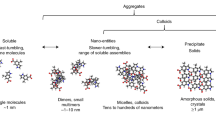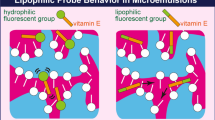Abstract
Many bioactive substances face the problem of limited bioavailability, mainly due to low aqueous solubility and poor metabolic stability. Their complexation with drug delivery systems offers a more optimum pharmacological profile. Some of these drug delivery systems that have promising potential form complexes with bioactive compounds such as cyclodextrins and calixarenes. The monitoring of the success and the type of the complexation are of great importance and two-dimensional diffusion-ordered NMR spectroscopy (2D DOSY) is a valuable tool for the studying of these complexes and described as “NMR chromatography.” Herein we report the procedure for the complexation of the natural product quercetin in 2-hydroxypropyl-β-cyclodextrin and the anticancer drug temozolomide in p-sulfonatocalix[4]arene and the determination of the complexation with 2D DOSY spectroscopy.
Access this chapter
Tax calculation will be finalised at checkout
Purchases are for personal use only
Similar content being viewed by others
References
Spencer JPE et al (2003) Intracellular metabolism and bioactivity of quercetin and its vivo metabolites. Biochem J 372(1):173–181
Smith AJ et al (2011) Cocrystals of quercetin with improved solubility and oral bioavailability. Mol Pharm 8(5):1867–1876
Day AJ et al (2001) Human metabolism of dietary flavonoids: identification of plasma metabolites of quercetin. Free Radic Res 35(6):941–952
Ferry DR et al (1996) Phase I clinical trial of the flavonoid quercetin: pharmacokinetics and evidence for in vivo tyrosine kinase inhibition. Clin Cancer Res 2(4):659–668
Figueiras A et al (2007) Solid-state characterization and dissolution profiles of the inclusion complexes of omeprazole with native and chemically modified beta-cyclodextrin. Eur J Pharm Biopharm 67(2):531–539
Mendes C et al (2015) Quantitative analysis of norfloxacin in β-cyclodextrin inclusion complexes—development and validation of a stability-indicating HPLC method. Anal Sci 31(10):1083–1089
Kellici TF et al (2016) Mapping the interactions and bioactivity of quercetin-(2-hydroxypropyl)-β-cyclodextrin complex. Int J Pharm 511(1):303–311
Malanga M et al (2016) “Back to the Future”: a new look at hydroxypropyl beta-cyclodextrins. J Pharm Sci 105(9):2921–2931
Pitha J et al (1992) Preparation of drug: hydroxypropylcyclodextrin complexes by a method using ethanol or aqueous ammonium hydroxide as co-solubilizers. Int J Pharm 80(1):253–258
Trinadha Rao C et al (1992) Distribution of substituents in O-(2-hydroxypropyl) derivatives of cyclomalto-oligosaccharides (cyclodextrins): influence of increasing substitution, of the base used in the preparation, and of macrocyclic size. Carbohydr Res 223:99–107
Tan SK et al (2018) Serum long noncoding RNA HOTAIR as a novel diagnostic and prognostic biomarker in glioblastoma multiforme. Mol Cancer 17(1):74
Stupp R et al (2005) Radiotherapy plus concomitant and adjuvant temozolomide for glioblastoma. N Engl J Med 352(10):987–996
Roos WP et al (2007) Apoptosis in malignant glioma cells triggered by the temozolomide-induced DNA lesion O6-methylguanine. Oncogene 26(2):186–197
Zhou Q et al (2007) Preclinical pharmacokinetic and pharmacodynamic evaluation of metronomic and conventional temozolomide dosing regimens. J Pharmacol Exp Ther 321(1):265–275
Happold C et al (2012) Distinct molecular mechanisms of acquired resistance to temozolomide in glioblastoma cells. J Neurochem 122(2):444–455
Renziehausen A et al (2019) Encapsulation of temozolomide in a calixarene nanocapsule improves its stability and enhances its therapeutic efficacy against glioblastoma. Mol Cancer Ther 18(9):1497–1505
Webber MJ, Langer R (2017) Drug delivery by supramolecular design. Chem Soc Rev 46(21):6600–6620
Cohen Y, Avram L, Frish L (2005) Diffusion NMR spectroscopy in supramolecular and combinatorial chemistry: an old parameter—new insights. Angew Chem Int Ed 44(4):520–554
Acknowledgments
This work has been co-financed by the European Union and Greek national funds through the program “Support for Researchers with Emphasis on Young Researchers” (call code: EDBM34, ΚΕ 14995) and under the research title “Preparation and study of innovative forms of administration of pharmaceutical molecules targeting at improved pharmacological properties.”
Author information
Authors and Affiliations
Corresponding author
Editor information
Editors and Affiliations
Rights and permissions
Copyright information
© 2021 Springer Science+Business Media, LLC, part of Springer Nature
About this protocol
Cite this protocol
Chatzigiannis, C.M., Kiriakidi, S., Tzakos, A.G., Mavromoustakos, T. (2021). 2D DOSY NMR: A Valuable Tool to Confirm the Complexation in Drug Delivery Systems. In: Mavromoustakos, T., Tzakos, A.G., Durdagi, S. (eds) Supramolecules in Drug Discovery and Drug Delivery. Methods in Molecular Biology, vol 2207. Humana, New York, NY. https://doi.org/10.1007/978-1-0716-0920-0_18
Download citation
DOI: https://doi.org/10.1007/978-1-0716-0920-0_18
Published:
Publisher Name: Humana, New York, NY
Print ISBN: 978-1-0716-0919-4
Online ISBN: 978-1-0716-0920-0
eBook Packages: Springer Protocols




